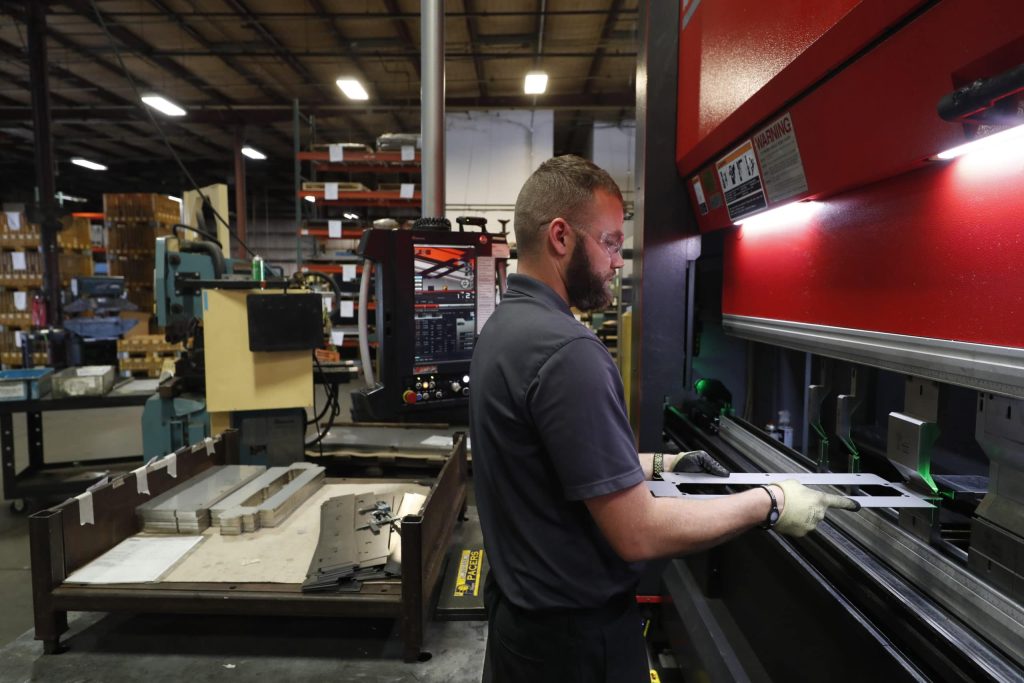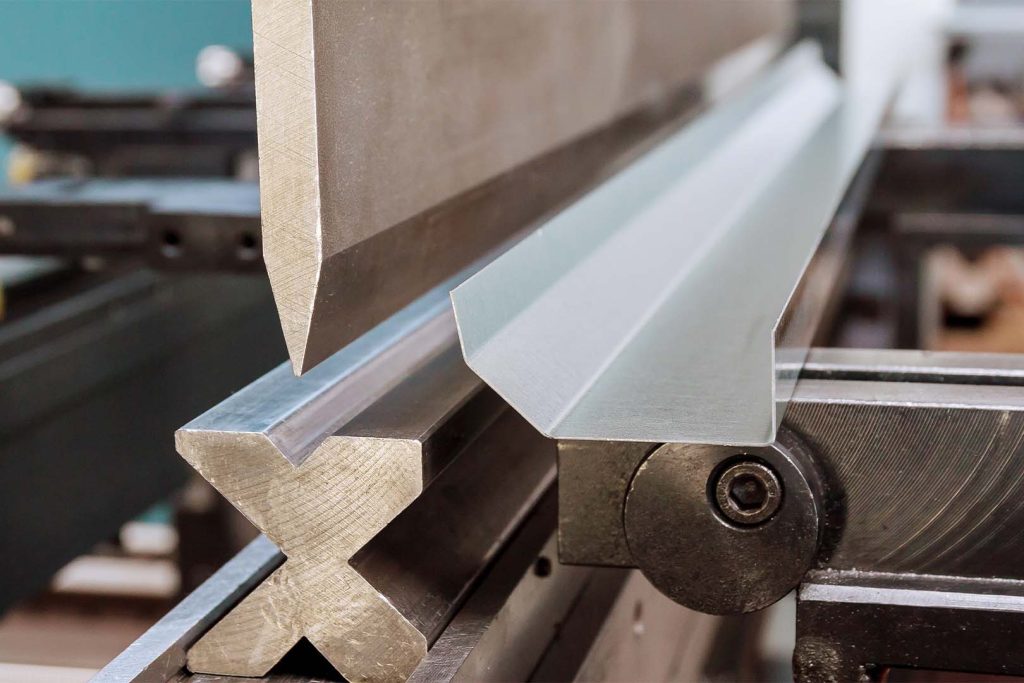Table of Contents
Bending sheet metal can be a daunting task, especially when it comes to creating precise 90-degree angles. However, with the right tools and techniques, anyone can learn how to bend sheet metal like a pro.
In this guide, we will explore the step-by-step process of bending sheet metal 90 degrees, including the tools you will need, the different types of bends you can make, and some helpful tips to ensure you get the perfect bend every time. Whether you are a seasoned metalworker or just starting out, you’re sure to find some valuable insights in this article. So, let’s get started!
- Secure the sheet metal in a vise or clamp.
- Place the bending tool at the point where you want the bend to start.
- Apply pressure to the tool to bend the metal to a 90-degree angle.
- Use a protractor or angle finder to check the angle of the bend.
- Release the metal from the vise or clamp.
How to Bend Sheet Metal 90 Degrees: A Comprehensive Guide
Bending sheet metal is a crucial skill for many industries, including construction, manufacturing, and automotive repair. Knowing how to bend sheet metal 90 degrees is particularly important, as it allows you to create precise angles and corners for your projects. In this guide, we’ll cover everything you need to know about bending sheet metal at a 90-degree angle, from choosing the right tools to properly measuring and marking your material.
Step 1: Choose the Right Tools
Before you start bending your sheet metal, you’ll need to gather the proper tools. The most important tool for bending sheet metal is a brake, also known as a bending machine. This machine consists of a flat surface with a clamping mechanism that holds your sheet metal in place while you bend it. Brakes come in a variety of sizes and styles, so it’s essential to choose one that’s appropriate for the thickness and size of your sheet metal.
You’ll also need a ruler or tape measure for measuring your sheet metal, as well as a marker or scribe for marking your bend lines. Depending on the complexity of your project, you may also need other tools such as snips, pliers, or a hammer.
Step 2: Measure and Mark Your Sheet Metal
Once you have your tools, it’s time to measure and mark your sheet metal. Start by measuring the length of the piece you want to bend, then use your ruler or tape measure to mark the bend line. Be sure to mark the line on the side of the sheet metal that will be facing up when you bend it.
Next, use your brake or clamping mechanism to secure your sheet metal in place. Make sure it’s aligned with your bend line, then use your marker or scribe to mark the edge of the brake where your sheet metal will be bent.
Step 3: Make Your Bend
With your sheet metal securely in place and your bend line marked, it’s time to make your bend. Start by bending the sheet metal up or down, depending on the location of your bend line, until it reaches a 45-degree angle. Then, release the clamping mechanism and reposition your sheet metal, so the bend line is aligned with the edge of the brake.
Finally, use your hands or a hammer to bend the sheet metal the rest of the way until it reaches a 90-degree angle. Be sure to apply even pressure to both sides of the sheet metal to avoid any kinks or wrinkles.
Step 4: Check Your Work
Once you’ve made your bend, it’s essential to check your work for accuracy. Use your ruler or tape measure to confirm that your sheet metal is bent at a perfect 90-degree angle. If necessary, make any adjustments by repeating the bending process.
Step 5: Finish Your Project
With your sheet metal properly bent, you’re ready to finish your project. Whether you’re creating a piece of artwork, building a structure, or repairing a vehicle, knowing how to bend sheet metal 90 degrees is a valuable skill that will serve you well in a variety of industries.
Benefits of Bending Sheet Metal 90 Degrees
Bending sheet metal at a 90-degree angle is a versatile skill that offers many benefits. For example, it allows you to create precise corners and angles for your projects, which is particularly important in construction and manufacturing. Additionally, bending sheet metal can help improve the overall strength and durability of your materials, making them more resistant to bending, breaking, or warping.
Bending Sheet Metal vs. Welding
While welding is another common method for joining and shaping sheet metal, it’s not always the best option. Bending sheet metal offers several advantages over welding, including greater precision, lower cost, and fewer potential defects or weaknesses. Additionally, bending sheet metal allows you to create more intricate designs and shapes than welding, which can be particularly useful in artistic or decorative applications.
Conclusion
Bending sheet metal 90 degrees is a valuable skill that can benefit professionals in a variety of industries. By choosing the right tools, measuring and marking your sheet metal accurately, and using proper bending techniques, you can create precise angles and corners for your projects. Whether you’re building a structure, repairing a vehicle, or creating a work of art, knowing how to bend sheet metal is an essential skill that will serve you well for years to come.
Frequently Asked Questions
Here are some common questions and answers about how to bend sheet metal 90 degrees:
What tools do I need to bend sheet metal?
To bend sheet metal 90 degrees, you will need a few basic tools such as a metal brake, a mallet or hammer, and a ruler or measuring tape. A metal brake is a special tool that allows you to bend sheet metal accurately and easily. You can also use a mallet or hammer to bend the metal by hand, but this can be more difficult to achieve precise angles.
Before you start bending, make sure you have all the necessary tools and equipment on hand. You may also want to wear protective gloves and eyewear to keep yourself safe while working with sheet metal.
What is the best way to measure sheet metal for bending?
Measuring sheet metal accurately is crucial to achieving a precise 90-degree bend. To measure the length of the metal, use a ruler or measuring tape and mark the length with a pencil or marker. To measure the width of the metal, use a caliper or a ruler with a built-in gauge.
When measuring, make sure to take into account the thickness of the metal and add a little extra length to account for the bend. This will ensure that the final product is the correct size and shape.
How do I use a metal brake to bend sheet metal?
A metal brake is a specialized tool that allows you to bend sheet metal accurately and easily. To use a metal brake, place the sheet metal in the brake and adjust the bending angle to 90 degrees. Then, use the handle to apply pressure and bend the metal to the desired angle.
Make sure to use the metal brake according to the manufacturer’s instructions and take care not to apply too much pressure, as this can cause the metal to warp or break. Practice on a scrap piece of metal before attempting to bend your final product.
What are some common mistakes to avoid when bending sheet metal 90 degrees?
One common mistake when bending sheet metal is not measuring accurately. This can result in a misshapen or uneven bend. Another mistake is applying too much pressure when using a metal brake, which can cause the metal to warp or break.
To avoid these mistakes, make sure to measure carefully, use the correct tools and equipment, and take your time when bending the metal. Practice on a scrap piece of metal before attempting to bend your final product.
What are some tips for bending sheet metal 90 degrees?
When bending sheet metal, it is important to take your time and work carefully to achieve a precise 90-degree angle. Some tips for bending sheet metal include using a metal brake for accuracy, measuring carefully, and using a mallet or hammer for small adjustments.
You may also want to wear protective gloves and eyewear to keep yourself safe while working with sheet metal. Practice on a scrap piece of metal before attempting to bend your final product, and don’t be afraid to ask for help from a professional if you’re unsure about how to proceed.
In conclusion, bending sheet metal at a 90-degree angle is not a difficult task, but it does require some technical knowledge and practice. With the right tools and techniques, anyone can master this skill and create precise and accurate bends for their projects.
Firstly, it’s essential to choose the right tool for the job, such as a brake or a press brake. Both of these tools can provide excellent results, but they require different techniques and setups. Always make sure to follow the manufacturer’s instructions and safety guidelines when using these tools.
Secondly, proper technique is crucial when bending sheet metal. Start by measuring and marking the desired bend location, then use the tool to create a straight bend. Next, use a mallet or hammer to finish the bend and create a crisp, clean angle. Always double-check your measurements and adjust the tool as needed to ensure accuracy.
Lastly, practice makes perfect. Don’t be discouraged if your first few bends aren’t perfect. Take the time to learn from your mistakes and make adjustments as necessary. With patience and persistence, you’ll soon be able to bend sheet metal like a pro.
In summary, bending sheet metal at a 90-degree angle requires the right tools, proper technique, and practice. By following these tips and techniques, anyone can create precise and accurate bends for their projects. So, get out there and start bending!
Request a quote today!
[contact-form-7 id="1578" title="Contact form"]
Please compress the file into a ZIP or RAR file before uploading. Alternatively, send through your RFQ by email.
enquires@unitymanufacture.com




